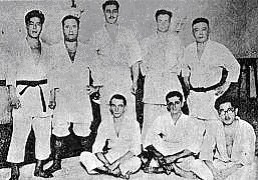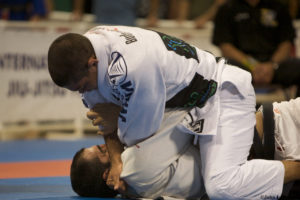
MMA101: What exactly is BJJ or Brazilian Jiu-jitsu?
Picture this: You come over to a friend’s house to watch the UFC with some buddies. The first beer is taken out of the cooler and someone calls for a pizza. The excitement builds. The very first fight of the evening is about to begin. As one fighter enters the cage, one of the commentators mentions that he “has an excellent BJJ background”. All your friends nod in agreement. But you have absolutely no idea what he means. You’re too embarassed to ask your buddies what BJJ means in fear of being labelled a “girly man”.
You might have heard your fight fan friends talk endlessly about BJJ and BJJ black, brown or blue belts. The also talk about how this fighter supposedly has better BJJ than the other fighter.They throw around the term BJJ so much that it must be something pretty basic. So much so that you don’t want to look like a dummy and ask “What the heck is BJJ?”
Perhaps you’ve figured that BJJ stands for Brazilian Jiu-jitsu. But what is Brazilian Jiu-jitsu? It’s Jiu-jitsu Japanese? They say it’s Brazilian. Is it a sport? Is it a martial art? Did it really come from Brazil?
We’ll try answer these questions with a detailed long answer then we’ll top it off with a short answer / conclusion at the very end.
The long answer:
Japanese origin

From Japan, judo founder Jigoro Kano sent one of his best students, Mitsuyo Maeda, overseas to promote his martial art worldwide. (It should be noted that judo or Kano jiu-jitsu as it was also know that time was becoming known for its techniques in throwing and ground fighting, the latter heavily influenced by the Fusen Ryu school of jiu-jitsu.) Maeda left Japan in 1904 and toured a number of countries to fulfill his mission. He held demonstrations and challenge matches versus practitioners of other combat arts and soon found himself on Brazilian shores in 1914.
Three years later in the South American country, Carlos Gracie then 14 years old, started to train in judo under Maeda. Carlos then shared his new-found passion with his brothers.
Brazilian innovation

Carlos’ younger sibling Hélio Gracie developed and focused more on the imported martial art’s ground fighting techniques. For him, jiu-jitsu—a grappling martial art wherein a jacket or gi is worn (like judo)—should enable a weaker and/or smaller individual with effective techniques versus defending a bigger and stronger attacker or competitor. His and his family’s style of jiu-jitsu favored technique and leverage over sheer strength and power, and became popular for bringing the fight to the ground more by pulling the adversary down than throwing him down like in judo or wrestling.
Also, another Brazilian student in Luiz França started propagating the art, and his lineage still survives in current world-renowned grappling and MMA teams.
This style that was fast gaining numerous disciples in Brazil eventually earned recognition as having the most advanced methodology in fighting while lying on one’s back. This position is called the guard, in which the supine fighter wraps or attempts to wrap or bind his legs against the opponent on top for a superior position. The ultimate objective of this style of jiu-jitsu is to make the opponent surrender under uncomfortable submission holds, which if not released, could cause pain, injury (or worse) to their recipients. Surrender or submission is expressed by tapping out with the hand (and sometimes, foot) or by verbally saying it (the louder the safer).
A sport and martial art
Continuing Maeda’s way of engaging in matches against other combat sports athletes and martial arts practitioners, the Gracie family and their style that was eventually known as Brazilian Jiu-jitsu became more popular—especially with their victories. It was also through their athletes’ experiences in these no holds barred (NHB) matches (arguably and technically “minimum holds barred,” as few moves were still actually disallowed) that BJJ further refined its techniques, to render them more effective. Participating in these matches, the BJJ representatives, depending on the rules, either wore their traditional Japanese-style uniform gi or otherwise (no gi).
Eventually, the Gracie family helped organize the world’s leading MMA promotion, the Ultimate Fighting Championship (UFC), in the early 1990’s. With their representative Royce Gracie winning its very first, then second and fourth events, BJJ’s popularity exploded on a global scale.
Presently, international BJJ sports competitions are organized regularly, and no gi competitions are also held in these events. While Brazil is the recognized homeland of this sport, the sport has taken roots all over the world. Some examples of the more prestigious competitions are the Pan American Championship, European Championship, and the Mundials, all of which are organized by the International Brazilian Jiu-Jitsu Federation (IBJJF).
BJJ is also a martial art. Beyond just the Japanese-style uniforms, the aspect of BJJ with retains tradition, builds character, and values skill and wisdom has inspired devotion from many BJJ practitioners. Like many martial arts, it is also possible to earn colored belts, with the black belt being the ultimate goal, to attest to your skill. Off the mat, the self-defense aspect of BJJ—if properly applied—is highly effective and could save a prospective a practitioner’s life or those of his loved ones from a criminal attack.

The short answer:
Brazilian Jiu-jitsu or BJJ is Brazilian martial arts with Japanese roots, thus its name. While Brazil is its recognized homeland, the sport has spread wide with practitioners around the world, and major international competitions being organized. As a martial art it has very effective self-defense applications.

Other articles you may be interested in if you enjoyed this one:
For a more comprehensive look at origins of Brazilian Jiu-jitsu at the take a deep dive into its history and its Japanese roots, and its dramatic introduction to the world in this article: Is Brazilian Jiu-jitsu Really from Brazilian – A Deep Dive into the History of Brazilian Jiu-jitsu
Further reading on our website:
MMA101: What are the rules of MMA?
I once dreamt of being an MMA Champion
Why is your boss is scarier than your MMA opponent
5 things I changed in the way I train in MMA and grappling by the time I hit my thirties
Further suggested reading: A Book About Mitsuyo Maeda one of Original Japanese Jiu-jitsu Teachers in Brazil
The Toughest Man Who Ever Lived (2007)
Picture credits: Main photo/John Lamonica; Full Mount/John Lamonica


Leave a Reply